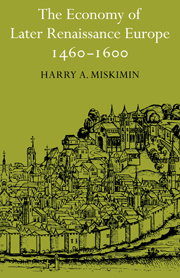Book contents
- Frontmatter
- Contents
- List of tables, graphs, maps
- Dedication
- Preface
- 1 The abstractions of law and property
- 2 Recovery: population and money supply
- 3 Agriculture: the rising demand for food
- 4 Industry: technology and organization
- 5 Trade patterns in the wider world
- 6 Finances: private and public
- 7 Retrospect
- Notes
- Bibliography
- Index
4 - Industry: technology and organization
Published online by Cambridge University Press: 30 September 2009
- Frontmatter
- Contents
- List of tables, graphs, maps
- Dedication
- Preface
- 1 The abstractions of law and property
- 2 Recovery: population and money supply
- 3 Agriculture: the rising demand for food
- 4 Industry: technology and organization
- 5 Trade patterns in the wider world
- 6 Finances: private and public
- 7 Retrospect
- Notes
- Bibliography
- Index
Summary
The forces that structured and influenced the market for manufactured goods during the sixteenth century were more complex and multidimensional than those that swelled the demand for foodstuffs. True enough, monetary recovery and the general expansion of population tended to raise the demand for the products of the artisans of Europe, but the connections between increased numbers and increased consumption were not direct. Since a certain minimal caloric intake is necessary to sustain life and since there are upper, though less definite, limits to the amount of food which even the most affluent human is apt to ingest, the demand of any given individual for foodstuffs is relatively inelastic. As a result, the aggregate demand for food closely follows demographic trends. The sixteenth-century demographic resurgence clearly heightened the pressures on the food supply. When output failed to keep pace with population growth, agricultural prices soared and real wages plummeted, but what of the demand for manufactured goods? It is a commonplace both of economic theory and of economic history – at least in regard to the behavior of an individual acting within the constraints of a limited budget – that when the cost of necessities increases sharply, the demand for luxuries and peripheral goods declines. In the postplague period of the fourteenth and fifteenth centuries, depopulation, by curtailing demand, lowered agricultural prices and thus enabled numerous consumers to offset their terror with wine, exotic foods, and the luxury manufactures previously available only to the very wealthy.
- Type
- Chapter
- Information
- The Economy of Later Renaissance Europe 1460–1600 , pp. 83 - 122Publisher: Cambridge University PressPrint publication year: 1975



